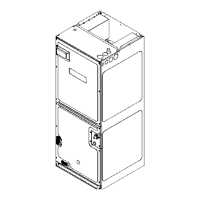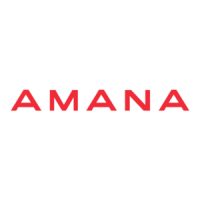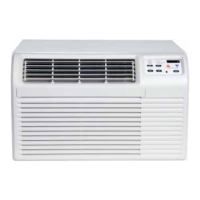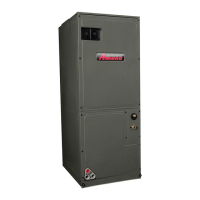4
5.3 Interconnecting Tubing
Give special consideration to minimize the length of refrig-
erant tubing when installing air handlers. Refer to outdoor
AIR CONDITIONING OR HEAT PUMP INSTALLATION &
SERVICE REFERENCE for line set conguration guide-
lines. If possible, allow adequate length of tubing such
that the coil may be removed (for inspection or cleaning
services) from the cabinet without disconnecting the
tubing.
5.4 Clearances
The unit clearance from a combustible surface may be
0”. However, service clearance must take precedence. A
minimum of 24” in front of the unit for service clearance
is required. Additional clearance on one side or top will
be required for electrical wiring connections. Consult all
appropriate regulatory codes prior to determining nal
clearances. When installing this unit in an area that may
become wet (such as crawl spaces), elevate the unit with
a sturdy, non-porous material. In installations that may
lead to physical damage (i.e. a garage) it is advised to
install a protective barrier to prevent such damage. Always
install units such that a positive slope in condensate line
(1/4” per foot) is allowed.
5.5 Horizontal Applications
If installed above a nished living space a secondary
drain pan, as required by many building codes, must be
installed under the entire unit and its condensate drain
line must be routed to a location such that the user will
see the condensate discharge.
If the unit is located in an unconditioned area with high
ambient temperature and/or high humidity, the air handler
may be subject to nuisance sweating of the casing. On these
installations, a wrap of 2” berglass insulation with a vapor
barrier is recommended.
Maximum operating pressure is considered when connecting
to any condenser unit or evaporator unit.
The EEV Series Air Handler product line may be installed in
one of the upow, downow, horizontal left or horizontal right
orientations as shown in Figures 3, 4, 5 and 6. The unit may
be installed in upow or horizontal left orientation as shipped
(refer to specic sections for more information).
Minor eld modications are necessary to convert to downow
or horizontal right as indicated in below sections.
For AHVE installations in areas where the return air enviro-
ment sees humidity levels above 65% relative humidity, a High
Humidity Kit (HHK) must be used. See Table 1 for Model and
Kit assignment.
Description Application
DPK1 Side Drain Port Plug All Models
6.1 Upow Installation
No eld modications are mandatory however to obtain
maximum eciency, the horizontal drip shield, side drain
pan and drain pan extension, can be removed.
Refer to
Figure 1, remove the two (2) screws that secure the drip
shield support brackets to the condensate collectors (front
and back). Unsnap the side drain pan from the bottom
drain pan using a screw driver or any small lever. The
side drain pan, drip shield brackets and the drain pan
extension may now be removed. From Figure 1, drain
port labeled (A) is the primary drain for this application
and condensate drain line must be attached to this drain
port. Drain port (a) is for the secondary drain line (if used).
If the side drain pan is removed, the drain port opening
in the access panel must be covered by the accessory
drain port plug (DPK1) as shown in gure 1.1.
6.2 Horizontal Left Installation
No eld modications are permissible for this applica-
tion.
Drain port labeled (B) in Figure 1 is the primary drain
for this application and condensate drain line must be
attached to this drain port. Drain port (b) is for the sec-
ondary drain line (if used).
In applications where the air handler is installed in the
horizontal left or right position, and the return air environ-
ment see humidity levels above 65% relative humidity
coupled with total external static levels above 0.5” e.s.p., a
Condensate Management Kit (CMK) is available for eld
application. Kit nomenclature can be found in the Table 2.

